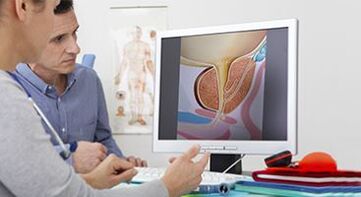Prostatitis and prostate adenoma are the most common diseases diagnosed in men. It is not surprising that he is interested in the symptoms and other features of the stronger sex. Let's understand how these pathologies differ and how they are treated.

Prostatitis and prostate adenoma are the most common diseases diagnosed in men.
What is the difference between prostate adenoma and prostatitis?
In fact, there is quite a difference.
These are due to the following factors:
- The onset of the disease.Prostate adenoma is usually diagnosed in men between the ages of 45 and 50, and prostatitis also affects young members of the stronger sex.
- The first symptoms.As a rule, patients with prostatitis complain of discomfort (including very obvious pain) and adenomas, urinary disorders.
- Reasons.Prostatitis is an inflammatory process and can be triggered by infections of the genital tract, and prostate adenoma is an overgrowth of tissue due to various factors.
- Clinical picture.Acute prostatitis is often accompanied by chills and fever, and the adenoma persists without signs of infection.
- The nature of pain.Inflammation is characterized by sharp pain in the groin, perineum and rectum. The tumor in the early stages can not be seen in any way. Even if the pain occurs, it is insignificant.
Sexual dysfunction is characteristic of both pathologies.
Causes of prostatitis

The disease mainly develops under the influence of microorganisms that enter the prostate gland from various sources. As a rule, prostatitis occurs against the background of sexually transmitted infections.
The disease mainly develops under the influence of microorganisms that enter the prostate gland from various sources.
Some experts divide stagnant prostatitis into a separate group. The disease is triggered by circulatory disorders in the small pelvis. Against this background, inflammation occurs. The infection merges fairly quickly. As a result, congestive prostatitis becomes chronic.
Symptoms of the disease
Prostatitis can take two forms: acute and chronic.

Not in all cases, acute prostatitis occurs with obvious symptoms. Some men report only general discomfort, mild pain, and temporary impairment of sexual function.
The following symptoms are typical for the acute form:
- pain in the perineum;
- feeling of pain under the scrotum;
- increased body temperature;
- pain during defecation;
- increased urination;
- frequent painful urination to urinate;
- erectile dysfunction.
Patients also complain of purulent and mucous discharge from the urethra, burning pains in the perineum and groin, excessive agitation, and painful discharge.
It is important! Not in all cases, acute prostatitis occurs with obvious symptoms. Some men report only general discomfort, mild pain, and temporary impairment of sexual function. These symptoms are a slow form of prostatitis and are similar to prostate adenoma, which can lead to errors in diagnosis.
Chronic pathology is characterized by 3 main groups of symptoms:
- It's painful.Men complain of pain in the rectum and lower back, a feeling of lumbago, tingling in the groin, thighs, perineum and waist, and "gas bumps. "Against this background, the patient may be nervous. Men also report sweating and chills.
- Urinary excretion.Men complain of slow urine flow, trying to empty the bladder, and frequent urges to go to the toilet.
- Sexual dysfunction.Patients experience a decrease in libido, lack of ejaculation, or premature, complete erection. Infertility often occurs against the background of prostatitis.

Pelvic nerves are often involved in the pathological process. As a result, additional symptoms are added to the main symptoms of prostatitis. These include hot flashes and fever in the evenings, tachycardia, as well as mood swings and concentration problems. Some men complain of fatigue and drowsiness during the day, suspicion, a lump in the throat, increased saliva production, weight gain (without changing diet and physical activity).
The cause of benign proliferation of glandular tissue is a change in testosterone metabolism in cells.
Causes of prostate adenoma
The cause of benign proliferation of glandular tissue is a change in testosterone metabolism in cells. This process is inevitable and begins in men at the age of about 40-45. Therefore, every member of the stronger sex has some degree of pathological symptoms. In general, a benign tumor has no obvious symptoms in the first stage, but is already diagnosed in 2 or 3.
Signs of the spread of glandular tissue
The difference between prostatitis and prostate adenoma lies in the main symptom. With a small tumor, urinary incontinence always comes to the fore.

The difference between prostatitis and prostate adenoma lies in the main symptom. With a small tumor, urinary incontinence always comes to the fore.
They are generally divided into 2 groups:
- Irritant symptoms.Patients complain of increased urination, the need to regularly empty the bladder at night, not to urinate.
- Obstructive symptoms.These are a result of the narrowing of the urethra as the gland enlarges. When urinating, they feel the need for compression, a weak urine flow, and drips.
As the disease progresses, the kidneys, ureters and pelvis become involved in the pathological process. This leads to increased blood pressure, back pain, constant thirst, itching, weakness and general deterioration of well-being. Patients develop pathologies of the cardiovascular system. In addition, men complain of suffocation of sexual function. Infectious complications of prostate adenoma are also found. In some cases, stones form in the bladder. Symptoms of varicose veins (if any) may also worsen.
Principles of treatment of prostatitis and prostate adenoma
Disease therapy is carried out using different groups of drugs.
Prostatitis treatment:
- suppression of the inflammatory process;
- cessation of active bacterial growth;
- improving lymph and blood flow in the small pelvic vessels;
- prevention of chronicity of the pathological process.
For this purpose, patients are prescribed anti-inflammatory and antibacterial drugs, as well as venotonics and blood thinners. Enzyme agents and stimulants of the immune response are recommended.
Treatment of prostate adenoma is as follows:
- noise reduction;
- restoration of normal urinary excretion.
To solve these problems, patients are prescribed alpha-blockers, 5-alpha-reductase inhibitors, phytopreparations and other substances.

Both prostatitis and prostate adenoma may require restoration of strength. For this purpose, combined preparations based on plant substances and other components are prescribed. The funds can be used simultaneously with the treatment of underlying pathologies. When taken properly, they are not harmful to the body.
It is important! Any medication is prescribed only by a doctor. Self-medication is strictly prohibited. It can change the clinical picture and cause difficulties in diagnosis. In addition, self-medication can worsen well-being. You should not cancel the medication yourself!
In some cases, surgery is used to treat the disease. Conservative therapy is prescribed if for one reason or another it is ineffective or inappropriate.
As a rule, surgical interventions are relevant in stages 2-3 of prostate adenoma.
The main operations include:
- TUR (transurethral resection);
- laser treatment;
- laparoscopy;
- interventions used in the Vinci robot.
All operations are minimally invasive. They reduce healthy tissue damage and provide a short rehabilitation period.

The surgical technique is selected by the doctor based on the available parameters, the patient's co-morbidities and individual characteristics.
Successful treatment of prostate adenoma and prostatitis includes:
- Abstinence from bad habits (smoking and alcohol abuse);
- Exclusion of animal fats, as well as canned foods, smoked and fried foods;
- Restriction in the diet of simple carbohydrates;
- Adequate fluid intake in the body (at least 2 liters of water);
- See your doctor regularly. You should contact him even if there are no pathological symptoms. This will allow all changes to be identified in a timely manner and prevent the development of complications.
Benefits of going to the clinic
- Experienced doctors.Our specialists have long been involved in the diagnosis and treatment of prostate pathologies. They have the necessary knowledge and skills to perform a wide range of manipulations.
- Opportunities for rapid diagnostics.Our specialists use specialist class equipment. Allows you to make a diagnosis on the day of treatment.
- Individual approach to therapy.Treatment of prostatitis and prostate adenoma is carried out taking into account the type and stage of the disease, the characteristics of the patient and the underlying disease.
- Conservative therapy using modern techniques.
- Modern surgical treatment methods.Surgical interventions use a laser and a Vinci robot. Laparoscopic operations and TUR (transurethral resection) are performed. This reduces the risks of interference and the duration of the rehabilitation period.
- Ease of visiting clinics.They are located near the subway. In addition, we are interested in the absence of queues and are ready to receive patients at a convenient time for them.
























